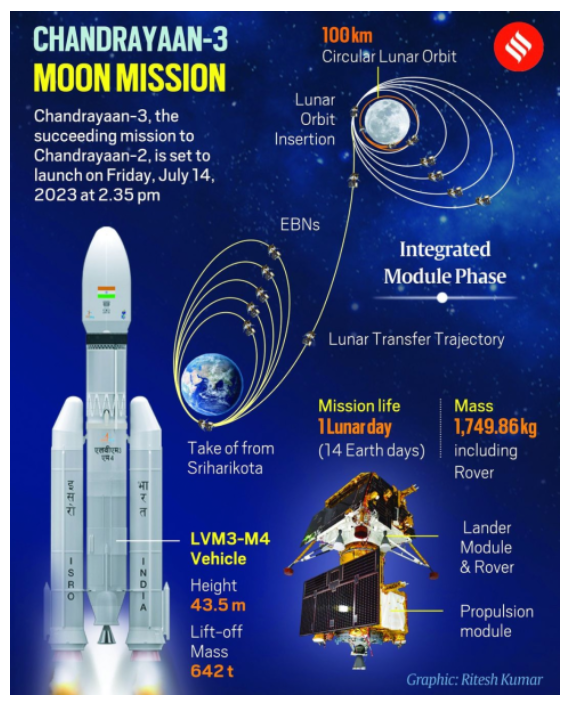Machine Learning Algorithms Pave the Way for Chandrayaan 3’s Mission
As the world continues to delve deeper into the realms of space exploration, the Chandrayaan missions have captivated the curiosity and imagination of people worldwide. These remarkable endeavors by the Indian Space Research Organisation (ISRO) have not only pushed the boundaries of lunar exploration but have also paved the way for groundbreaking missions like Chandrayaan 3. This article will delve into the untold saga of Chandrayaan missions, with a particular focus on Chandrayaan 3’s mission and the crucial role machine learning algorithms play in its success.
Unveiling Chandrayaan 3’s Ground Breaking Mission
Chandrayaan 3 represents a fresh endeavor toward the Moon, building upon the achievements and setbacks of its predecessors, Chandrayaan 1 and Chandrayaan 2. With a primary objective of further enhancing our understanding of the lunar surface, this mission aims to propel India’s space exploration to new heights. By utilizing cutting-edge machine learning algorithms, Chandrayaan 3 promises innovative insights and unparalleled advancements in the field of space science.
Role of Machine Learning in Chandrayaan 3’s Success
Machine learning has revolutionized various industries, and space exploration is no exception. In the context of Chandrayaan 3, machine learning algorithms play a pivotal role in ensuring the mission’s success. By leveraging the power of artificial intelligence, these algorithms facilitate data analysis and processing, enabling scientists to uncover hidden patterns and make informed decisions. The fusion of machine learning and space exploration not only enhances our understanding of celestial bodies but also propels mankind toward unprecedented discoveries.
Understanding Chandrayaan Missions
To comprehend the significance of Chandrayaan 3, it is essential to delve into the triumphs and setbacks of its predecessors. Chandrayaan 1 marked a giant leap for India’s space exploration, becoming the country’s first lunar mission. It successfully orbited the Moon and provided vital data about its terrain and mineral composition. However, Chandrayaan 2 faced challenges during its landing attempt on the lunar surface but still made significant strides in terms of orbiter functionality and imaging capabilities. These missions laid the foundation for Chandrayaan 3, which seeks to overcome previous hurdles and uncover new frontiers.
Machine Learning Revolutionizing Space Exploration
Machine learning applications have transformative potential in the field of space exploration. From enhancing data analysis to processing vast amounts of information, these algorithms offer unprecedented capabilities. By extracting valuable insights from complex datasets obtained from space missions, scientists can gain a deeper understanding of celestial bodies, space weather patterns, and the overall dynamics of the universe. Machine learning opens up doors for novel discoveries and expands our knowledge of the cosmos.
Machine Learning Algorithms in Chandrayaan 3
Chandrayaan 3 harnesses the power of machine learning algorithms in various ways. One crucial application lies in lunar terrain mapping, where deep learning algorithms process vast amounts of imagery data to create detailed and accurate maps. Additionally, image recognition algorithms assist in lunar exploration by identifying and categorizing various geological features and anomalies on the Moon’s surface. Moreover, predictive models powered by machine learning algorithms enable scientists to anticipate space weather patterns, enhancing the safety and efficiency of lunar missions.
Training Machine Learning Models for Space Exploration
Training machine learning models for space exploration necessitates the use of diverse and accurate training data. Simulations and virtual environments play a crucial role in providing realistic scenarios to train these models. By emulating lunar conditions and providing training data derived from past missions, scientists can equip machine-learning algorithms with the knowledge required to handle the challenges of space exploration. Nevertheless, training models for space missions pose unique challenges, such as the limited availability of labeled data and the need to ensure the models are robust and reliable.
Ensuring Robustness and Reliability
To guarantee the success of Chandrayaan 3, machine learning algorithms must exhibit robustness and reliability. Building redundancy and fault tolerance into these algorithms is essential to mitigate the risks associated with space missions. By accounting for unexpected data anomalies or hardware malfunctions, these algorithms can handle adverse conditions and make accurate decisions. Adapting machine learning models to extreme lunar conditions is also crucial, as the Moon presents a unique set of challenges and environmental factors that must be considered during algorithm development.
Collaborative Efforts for Success
The success of Chandrayaan 3, like any space mission, relies on collaboration and partnership between space agencies and technology companies. Pooling knowledge, expertise, and resources is crucial in pursuing lunar missions of such scale. International partnerships facilitate the exchange of ideas, technological advancements, and joint problem-solving. These collaborative efforts create a global platform for space exploration and lay the foundation for future missions, ultimately benefiting all of humanity.
Ethical Considerations in Space Exploration with Machine Learning
As machine learning algorithms become increasingly integral in space exploration, ethical considerations must be addressed. Privacy and security concerns surrounding the transmission of data from space to Earth require robust measures. The transparency of decision-making algorithms is also vital in order to maintain accountability and prevent biases from influencing mission outcomes. Establishing a framework of machine learning ethics in space exploration ensures the responsible and mindful development of these algorithms, safeguarding the integrity and objectivity of scientific exploration.
The Implications of Chandrayaan 3’s Success
Chandrayaan 3’s success holds immense implications for mankind’s understanding of the Moon. By advancing our knowledge of lunar terrain, mineral composition, and space weather patterns, it brings us closer to unlocking the mysteries of our celestial neighbor. Furthermore, the success of Chandrayaan 3 paves the way for future manned missions to the Moon, opening doors for human exploration and potential colonization. This momentous achievement also sparks inspiration among the next generation of space explorers, encouraging them to dream big and pursue careers in science and technology.
Source
- https://www.bitsathy.ac.in/chandrayaan-3-vs-nasas-tech-and-math-secrets/
- https://sailssoftware.com/how-ai-is-helping-chandrayaan-3-land-safely-on-the-moon/#:~:text=It%20uses%20a%20combination%20of,been% 20tested%20extensively%20in%20simulations.
- https://www.isro.gov.in/Chandrayaan3_Details.html
- https://www.blockchain-council.org/news/chandrayaan-3-how-ai-helped-india-to-become-the-first-nation-on-moons-south-pole/#:~:text=Artificial%20Intelligence%20(AI)%20played%20a,mission’s%20success%20by%20sharing%20expertise.

